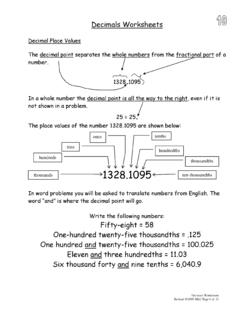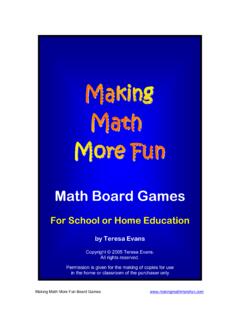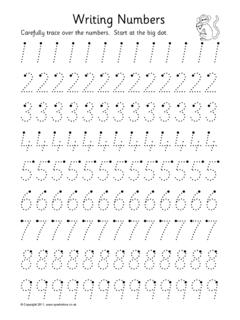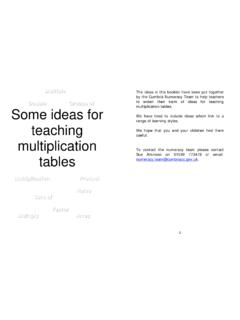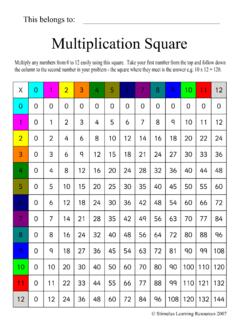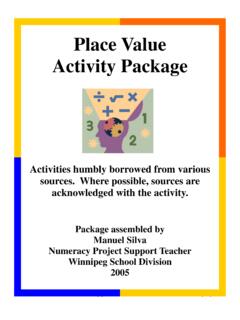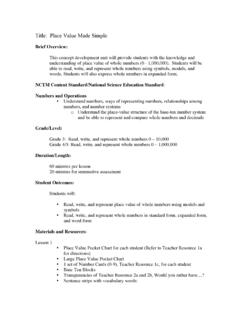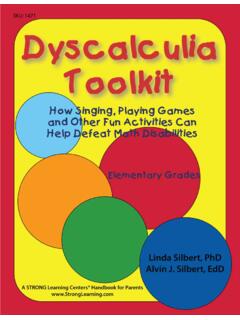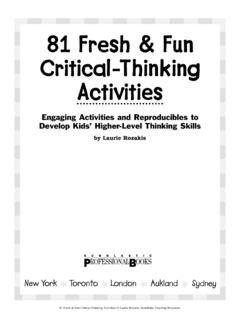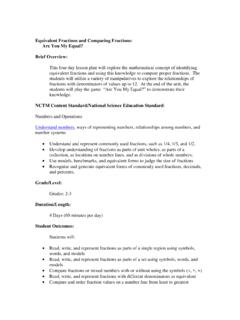Transcription of Mega-Fun Fractions - The Mathematics Shed
1 NEW YORK TORONTO LONDON AUCKLAND SYDNEYMEXICO CITY NEW DELHI HONG KONG BUENOS AIRESSCHOLASTICBPROFESSIONAL OOKSMEGA-FUNFRACTIONSby Marcia Miller and Martin LeeMega-Fun Fractions Miller & Lee, Scholastic Teaching ResourcesWith love to Daniel and Joshua BrandesScholastic Inc. grants teachers permission to photocopy the reproducible pages from this book for classroom use. No other partof this publication may be reproduced in whole or in part, or stored in a retrieval system, or transmitted in any form or by any means,electronic, mechanical, photocopying, recording, or otherwise, without written permission of the publisher. For information regardingpermission, write to Scholastic Inc., 557 Broadway, New York, NY design by Maria LiljaInterior design by Solutions by Design, and interior illustrations by Michael MoranISBN: 0-439-28844-4 Copyright 2002 by Marcia Miller and Martin rights reserved.
2 Printed in the 2 3 4 5 6 7 8 9 1040 08 07 06 05 04 03 02 Mega-Fun Fractions Miller & Lee, Scholastic Teaching ResourcesAbout This ACTIVITIESHALFNESSU sing visual estimation to determine a spatial reasoning game using pattern AT SINPETAL, MISSISSIPPI?Identifying Fractions of regions to solve a AT SLEFT?Using visual estimation to identify UP ATREEU sing visual and spatial estimation to dot-paper regions for given a schematic chart to represent TApplying Fractions to geometric designs on grid fraction concepts to create a class OCKPR OOFSE xploring equivalent Fractions with pattern equivalent Fractions on grid fraction concepts to describe parts of the fraction concepts in an ongoing, interactive bulletin fraction concepts to describe groupsshown in hands-on Fractions to create snack mixes.
3 28 FRACTIONMESSAGEF inding Fractions of words to solve a OFFRACTIONSC ompleting sentences with fraction Fractions and mixed numbers said ANDEGGCARTONSU sing empty egg cartons to model equivalent equivalent Fractions in a class equivalent Fractions in a card game TIMESTWOP laying Bingo games with equivalent Fractions and mixed fraction concepts through clay pies to compare EMUPE xploring hands-on Fractions to compare Fractions Miller & Lee, Scholastic Teaching ResourcesPROVEIT!Presenting a legal argument to prove a card game to compare , PART1 Playing a logic game to form the greatest andleast SANORDER!Playing a game that involves comparing andordering OF ADAYM aking a circle graph based on Fractions of a FORFRACTIONSU sing Fractions to express lengths of Fractions to express money problems that involve Fractions of a set of ANDAGESU sing Fractions and mixed numbers to express , PART2 Playing a logic game to form the greatest and least mixed Fractions in the form of standard musical HEAD FORFRACTIONSU sing mental math to add (or subtract)
4 INANCIENTEGYPTE xploring the fraction notation used in ancient a board game that involves adding logical reasoning to find fraction sums and ON AROLLP laying a game involving adding, comparing, and ordering HPUZZLESU sing logic to add and subtract logical reasoning to solve fraction OFPARTSE xploring the concept of multiplying Fractions on grid , ROUND,ANDRECORDP laying a game that involves multiplying Fractions and rounding ANDCALORIESU sing fraction concepts to interpret data in calorie and exercise original story problems to be solved using fraction AVENGERHUNTE stimating and measuring to find items in fractional fraction concepts in order to analyze a everyday uses of Fabulous MeasurMega-Fun Fractions Miller & Lee, Scholastic Teaching ResourcesABOUTTHISBOOKNCTM STANDARDSIn the 2000 edition of Principles and Standards for School Mathematics , theNational Council of Teachers of Mathematics (NCTM) states that students ingrades 3 5 should.
5 Develop understanding of Fractions as parts of unit wholes, as parts of acollection, as locations on number lines, and as divisions of whole numbersUse models, benchmarks, and equivalent forms to judge the size of fractionsDevelop and use strategies to estimate computations involving Fractions insituations relevant to students experienceUse visual models, benchmarks, and equivalent forms to add and subtractcommonly used fractionsOURGOALWe have written Mega-Fun Fractionsto provide in one resource a variety ofways for you to immerse your students in fraction concepts. All activitiesaddress one or more of the NCTM fraction standards listed above. The rangeof fraction lessons includes hands-on explorations and activities that invokeproblem solving, reasoning and proving, communicating, connecting, andrepresenting Fractions .
6 Cross-curricular activities link Fractions to language arts,music, science, art, and social hope that as you use the ideas in this book in your classroom, yourstudents will develop a deeper understanding of Fractions and become morecomfortable with this strand of the Mathematics curriculum. Our goal is to fostera strong conceptual understanding that, we believe, will lead to greater easein working with Fractions and rational numbers at more advanced Fractionsoffers activities written directly to the student as well asguided plans to help you present activities to your whole class, to smallgroups, or to individuals. Each lesson begins with a question you may pose tostudents, a learning objective, a list of necessary materials, sequenced steps tofollow (The Plan), and several follow-up ideas.
7 The back of the book has threepages of Fraction Quickies additional ideas presented in an abbreviatedmanner. You will also find helpful reproducibles and a Fraction Self-EvaluationForm that students complete. Answers appear at the end of the Activities Scholastic Professional Books5 Mega-Fun Fractions Miller & Lee, Scholastic Teaching ResourcesTEACHERTIPSThe activities in Mega-Fun Fractionsare organized according to a very broadoutline, and they are presented in this order: Fractions of a regionfractions of a setequivalent fractionscomparing, ordering, and rounding fractionsfractions and measurementadding, subtracting, and multiplying fractionsculminating activitiesFeel free to work through the book in any order that suits you. Revisit activities atany time during the may find that some fraction activities are too advanced for your class,whereas others may be too basic.
8 Revise, adapt, or extend tasks to suit yourstudents may choose to use the tasks in this book as full lessons, warm-ups, homeworkassignments, math corner activities, group projects, informal assessments, orportfolio assessments. It s upto you!Determine the best grouping to suit your teaching style, as well as the learningstyles and levels of your students. Invite students to work individually, in pairs, insmall groups, or as an entire class. Be sure to allow time for sharing sharing, discussing, analyzing, and summarizing of students an atmosphere that promotes intellectual exploration and anappreciation of and respect for one another as mathematicians, thinkers, may wish to duplicate and distribute the fraction strips (page 84) to providestudents with a ready reference for comparing and ordering Fractions .
9 Havestudents color each strip a different color for visual Prepare to Share feature on many student pages stimulates students to planwhat they wish to say when you summarize the activity. You may wish to askstudents to record their responses and ideas in a math you make manipulatives, such as fraction cards or fraction numbercubes, keep them for use in subsequent activities. If space permits, set up aFractions Center in your classroom where you can store such Fabulous Measur6 Mega-Fun Fractions Miller & Lee, Scholastic Teaching ResourcesHALFNESSCan you open a book to the halfway page? Can you pour half a glass of water? Can you walk halfway to the classroom door from your seat?GOAL:Students use their visual estimation skills to identify half of a :student page 8, various books, water glasses, dried beans or water, coins orcounters, string, pencils, various measurement tools (rulers, tape measures, scales,and so on)Begin by brainstorming with students everyday situations in which people make a quick visualestimate of half.
10 For example:I ll take half a piece, it up about it up about halfway between here and the book goes in the middle of the top by having students suggest other examples that involve estimating about half of a space, adistance, or a the class into pairs or small groups. Give each group a set of materials. Then direct groups totackle the visual estimation activities on page 8. Have students try each task more than once, andnote whether their estimates of half improve or stay about the students work, guide them to figure out ways to use suitable measurement tools to verify howclose to half their estimates actually students compare their estimates and strategies with those of other discussion of students strengths and weaknesses in visual students to describe orally or write a description of how and why their estimates changed withsubsequent students to create other tasks in which they visually estimate half of students to visually estimate half again of a distance or Activities Scholastic Professional Books7 Mega-Fun Fractions Miller & Lee.
